The best vegan ricotta with an authentic ricotta taste and texture and made with just four simple ingredients. It's light, fluffy, mild, creamy and milky and can be enjoyed as it is or used as a non-dairy substitute for ricotta cheese in any recipe.

💌 SAVE THIS RECIPE!
Watch out for more tasty treats coming your way too! Unsubscribe at any time.
This vegan ricotta recipe is incredible. I have been making it on repeat for months while perfecting the recipe and still can't get over how authentic it is. We're talking super light and fluffy and milky... So milky. It really is hard to believe it's vegan. And it can be used in litreally any way you would regular ricotta. I've been living my best vegan life while adding it to everything!
In this Vegan Ricotta Cheese post:
There are many vegan ricotta cheese recipes online but they aren't very authentic. They all involve blending up the ingredients to form a thick, dense, spreadable cheese like vegan tofu ricotta. They might taste ok but you're not going to get fluffy clouds of milky vegan ricotta that way.
My method of making homemade vegan ricotta is different and it really does make the best vegan ricotta. It is made just as the original is, by heating, curdling and straining and it gives you that authentic, light, almost fluffy texture and mild, milky flavour.
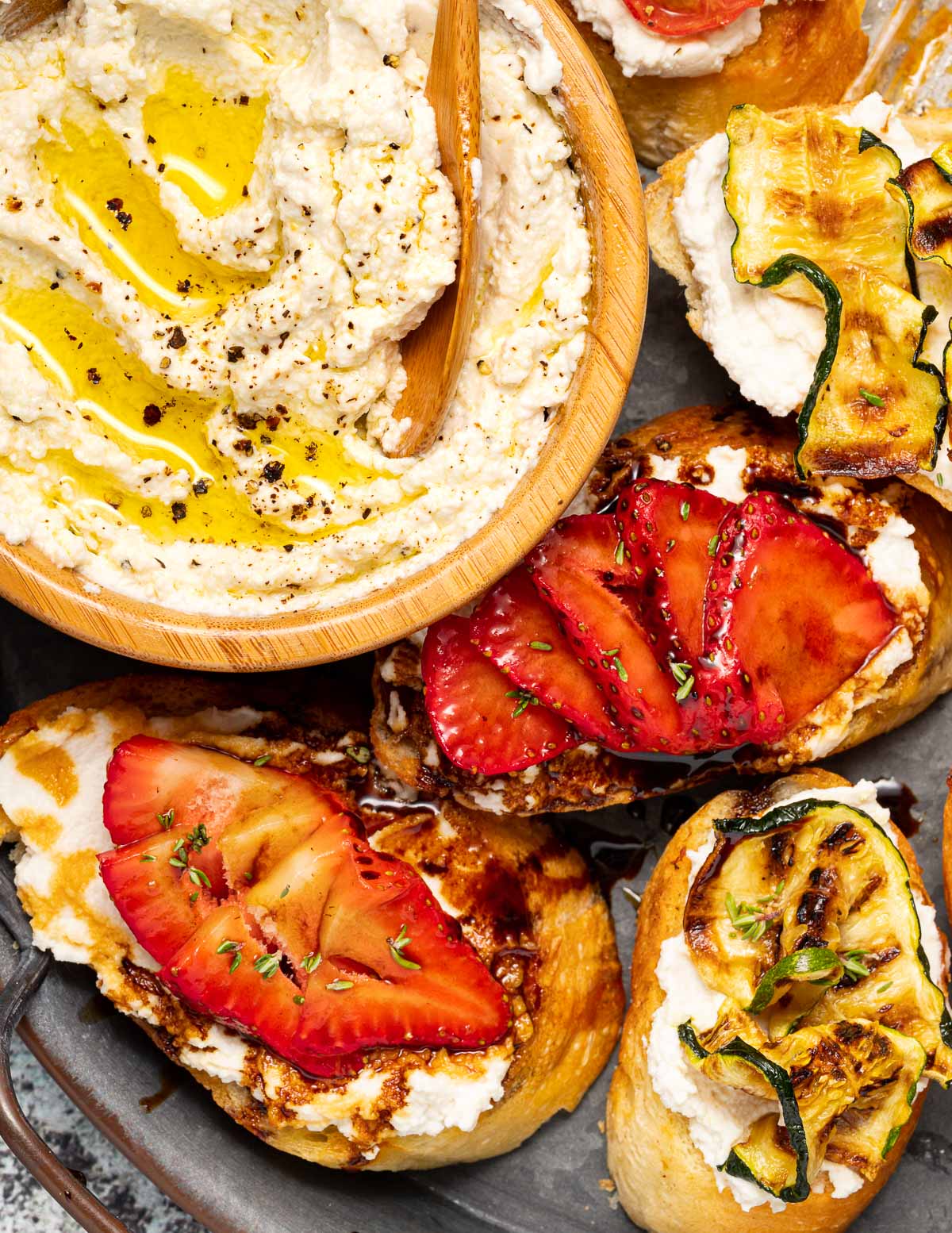
What is ricotta and is it vegan?
Can vegans eat ricotta cheese? The answer is no because traditional ricotta cheese is made from animal milk and vegans do not consume animal products. But, that's where my vegan alternative to ricotta comes in. This is a dairy-free ricotta with all of the taste and texture of real ricotta, without the involvement of any animals!
You might be surprised to know that ricotta isn't technically a cheese. It's actually a curd and is made from either cow, sheep or goat milk. It is soft, white, mild, slightly sweet and milky with an appearance not unlike cottage cheese.
Ricotta is used in abundance in all regions of Italy and is traditionally a by-product of the cheese-making process. The whey, which is leftover after cheese is made, gets heated to boiling in a metal container, sometimes with the addition of some fresh milk to enrich it, and the solids float to the top. They are skimmed off and poured into little baskets to drain. Then you have fresh ricotta.
Nowadays, tradition is often left behind for mass production purposes, and ricotta is made with whole milk which is coagulated with an acid, creating curds which are then strained, in a process very similar to the one we will be using to make this vegan ricotta recipe.
Ingredients & equipment
My vegan ricotta cheese is a very simple recipe with simple, naturally gluten-free ingredients but produces surprisingly fantastic and authentic results.
Here are the ingredients you need to make this vegan ricotta recipe:
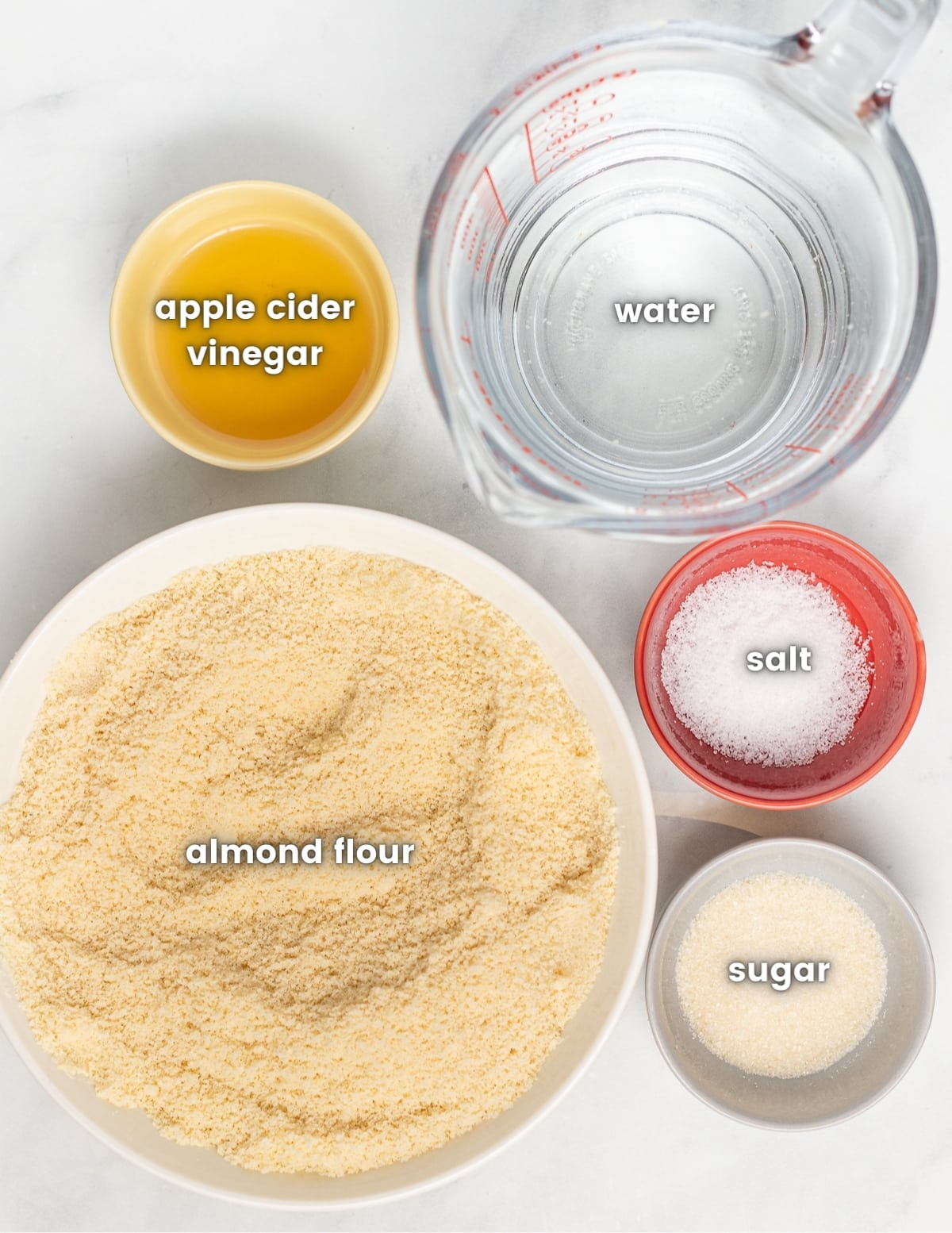
- Almond flour - It must be almond flour and not almond meal and you cannot use whole raw or slivered almonds. Once you've got some give my vegan parmesan a try too!
- Apple cider vinegar - Essential for its mild flavour and the way it curdles. You can use lemon juice but a lemon flavour might come through in the finished ricotta.
- Salt - Essential for flavour.
- Sugar - The recipe will not work without it. It aids the curdling effect.
Success Tip - Every single one of these ingredients is essential for making this vegan ricotta cheese recipe. If you want this recipe to work well you cannot substitute them for anything else.
As for equipment, you will need a blender (a food processor won't do for this recipe), a large saucepan, a sieve (or colander), some cheesecloth or a clean lint-free dishtowel, and a piece of string or an elastic band. A cheese mould is nice to have to make your cheese look amazing, but isn't necessary. I got this pack of 5 cheese moulds on Amazon.
How to make vegan ricotta
Here is how I make my Vegan Ricotta:
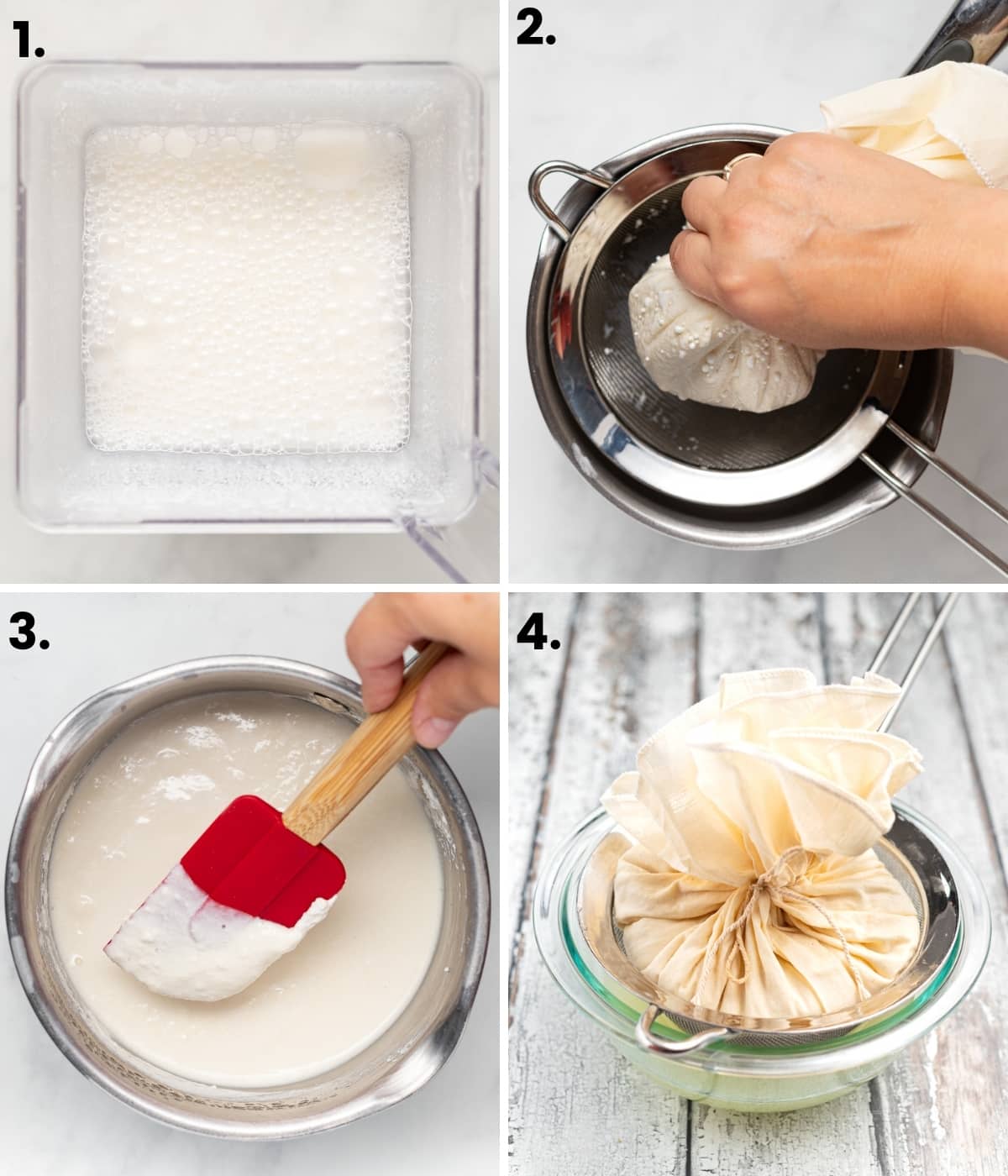
- Blend the almond flour, salt, sugar and water together until completely smooth, white and milky.
- Strain the mixture.
- Heat and add the vinegar then allow to cool to room temperature.
- Pour the curdled milk into a cloth and let it drain overnight in the fridge.
When you open the cheesecloth the next day you can use the ricotta right away, or you can press it into a cheese mould so that it looks super-duper professional and you feel like a vegan cheesemaking star!
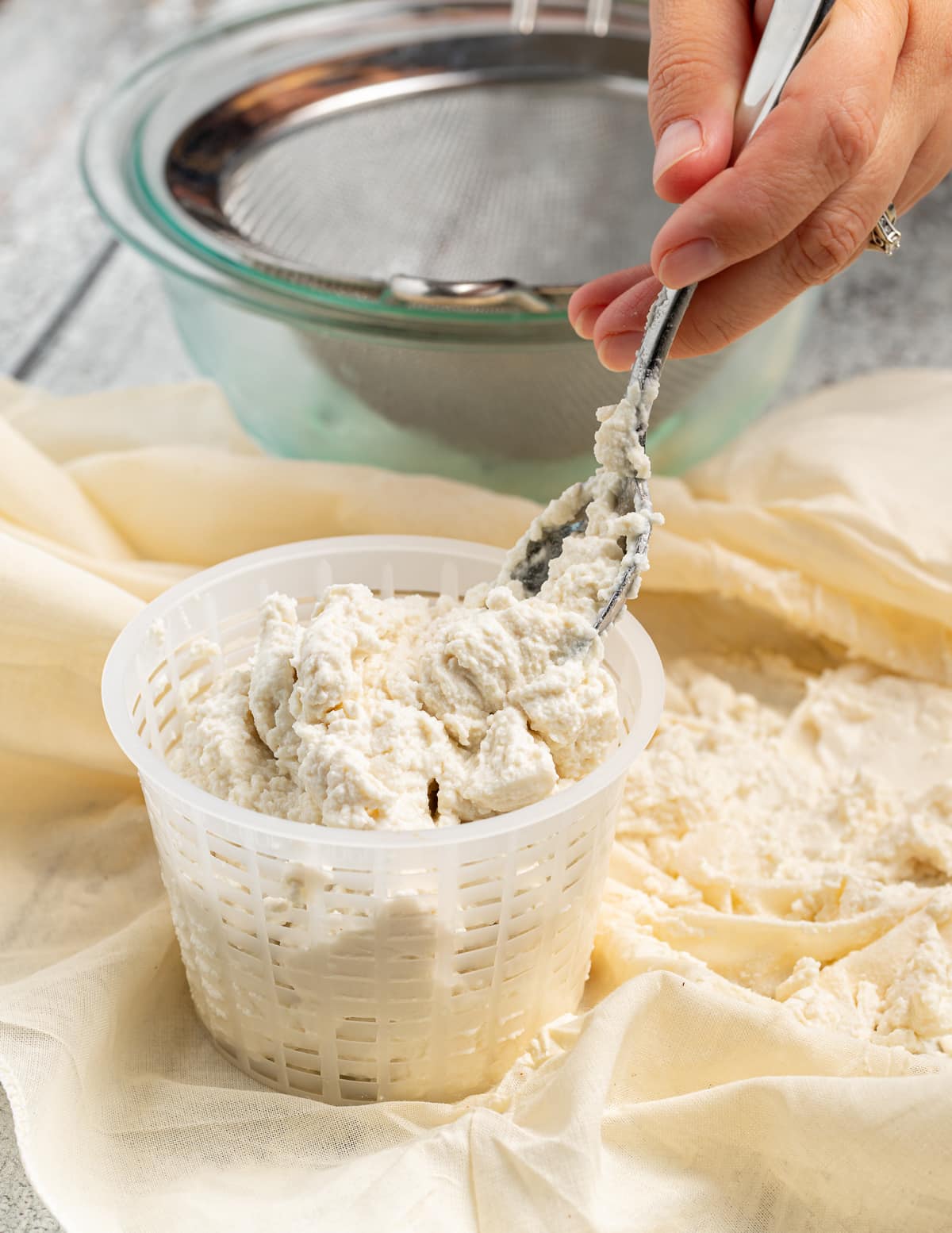
Then after a few hours chilling in the fridge, when you turn it out of the mould it will look like this:

Perfect for presenting on your vegan cheese or snack board with crackers, bread, olives, chutneys, roasted or raw vegetables, grapes and some vegetable pate.
Success Tip - Make sure you make your ricotta at least the day before you need it. It needs to drain through the cheesecloth overnight.
How to use vegan ricotta
My vegan ricotta cheese is extremely versatile and can be used as a direct substitute for ricotta cheese in any recipe. Enjoy it for breakfast, lunch, dinner and dessert, serve as it is or cook/bake it into all of your favourite treats. Its uses really are almost endless!
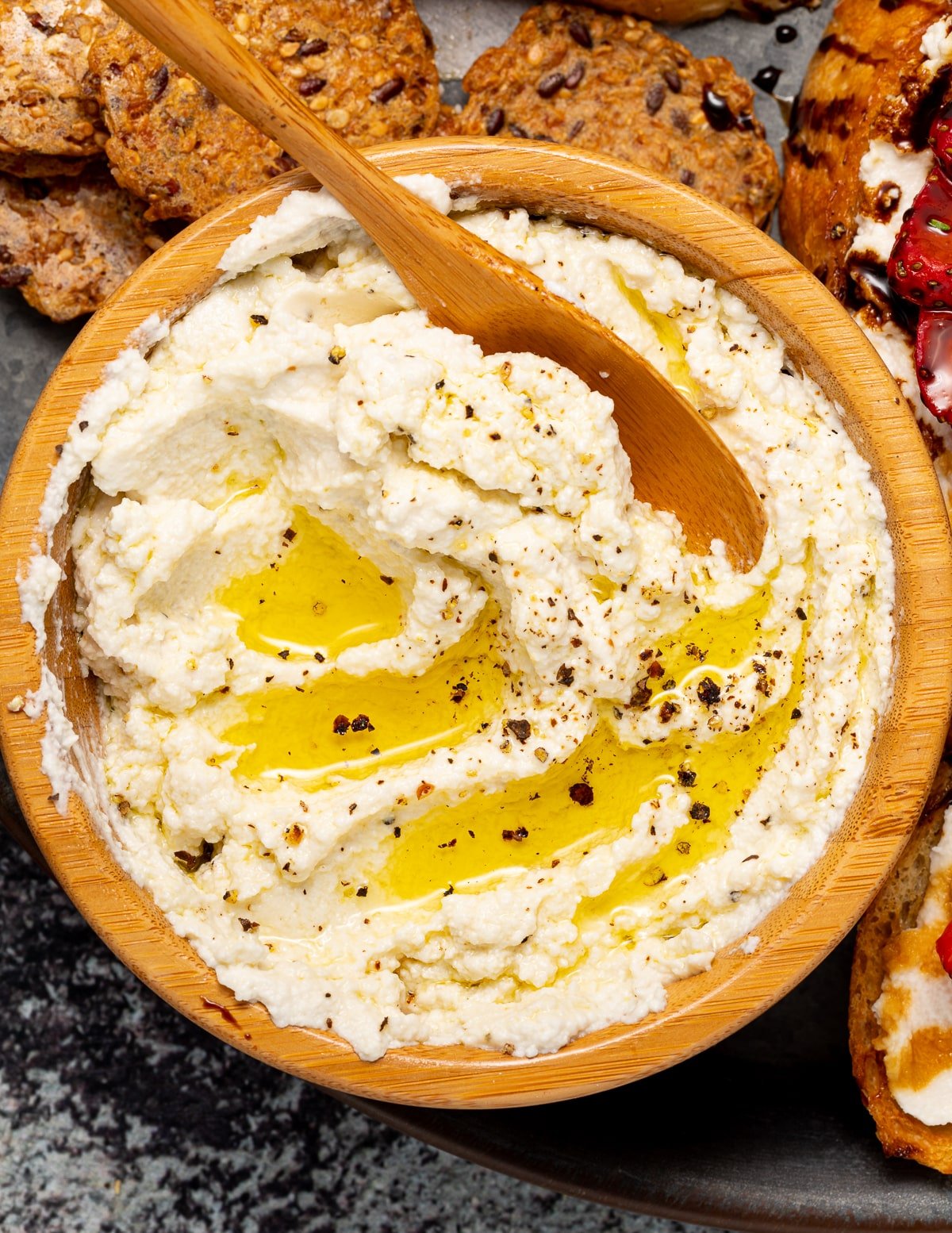
My favourite ways to use this almond ricotta include:
- drizzled with good olive oil, sprinkled with some fresh thyme or oregano and cracked black pepper then served on a vegan cheeseboard or snack board.
- whipped up in a bowl and spread onto bread, crackers, bruschetta etc.
- in salads like my strawberry spinach salad or lemon orzo salad
- it's the best vegan ricotta for lasagna!
- on pizza, soup or pasta dishes like my vegan vodka pasta, Vegan Italian Sausage Pasta Soup or my Vegan Tortilla Soup.
- fill cannoli, pasta shells, ravioli, tortellini, vegan English pancakes or crepes
- fill tarts, cakes, pavlova or Danishes (sweet or savoury)

How to store
Store dairy-free ricotta in an airtight container in the fridge for up to 2 weeks. It can also be frozen but the texture will change a bit because of its high moisture content. Defrost it overnight in the fridge then give it a good stir before using. Once defrosted its best used as part of a recipe like in a lasagna or stuffed shells.
Recipe FAQS
Almond flour is made from blanched skinless almonds and is super fine, powdery, soft and pale creamy yellow in colour. It has a mild, buttery flavour which is why it works so well in this, my vegan parmesan and in my vegan butter recipe. Almond meal on the other hand is made with raw almonds, often with skins still on. It is coarser, harder and grainier than almond flour, slightly stronger in flavour and darker in colour with small brown flecks throughout if the skins were still intact. Almond flour is found in almost all grocery stores and it will be clearly labelled on the bag that it is made from blanched almonds. I buy mine in bulk from Costco but Bob's Red Mill is a popular brand of almond flour carried in most stores in North America. In the UK you can usually buy almond flour from Holland and Barrett or get it from Amazon. Check out my other vegan almond flour recipes for more delicious ways to use almond flour!
You can compost it or re-use it in another recipe. You can make these almond pulp cookies (just omit the salt as the pulp is salted), or spread it in a thin layer on a baking tray and place in a really low oven until it has dried out completely. Then you can crumble it up and store it in a sealed jar. Add to homemade granola, baked goods, oatmeal or smoothies.
You can find many more vegan almond flour recipes here.
Recipe
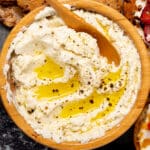
Vegan Ricotta
Author:WATCH HOW TO MAKE IT
Ingredients
- 1½ cups (168 grams) almond flour , it MUST be almond flour not almond meal
- 3 cups + 2 tablespoons (750 mls / 25 fl ozs) water
- 1 tablespoon white or cane sugar
- 1½ teaspoons fine sea salt
- ¼ cup (60 mls) apple cider vinegar
RECOMMENDED EQUIPMENT
INSTRUCTIONS
- To a blender add the almond flour, water, sugar and salt. Blend for at last a minute until white, completely smooth and milk-like.
- Place a sieve over a large saucepan. Line the sieve with cheesecloth, nut milk bag or very clean lint free dish towel, and strain the milk from the blender through it and into the pan. Give it a good squeeze to get the last of it out. Discard/compost the pulp or see the FAQ's for ways to use it in another recipe.
- Heat the blended milk in the pan over medium heat until just starting to boil. Wait until you see some vigorous boiling bubbles form then turn off the heat right away.
- Immediately add the vinegar to the hot milk and stir. Cover with a lid and leave at room temperature until completely cool. This will take several hours. You can easily leave it up to 6 to 7 hours if you need to go out. Don't be tempted to put it in the fridge to hurry it up. It needs to stay at room temperature.
- Once it is completely cool, set a sieve over a mixing bowl and line it with some fresh cheesecloth (or a very clean non fluffy dish towel). Carefully pour the curdled milk mixture into the cheesecloth, then bundle it up tightly at the top and tie with string or an elastic band.
- A lot of clear liquid will come out quite quickly. Pour it down the sink before putting the whole thing (bowl, sieve, and cheese sitting inside it) in the fridge overnight to drain. Don't be tempted to squeeze it to hurry it up because you will affect the texture of the ricotta. Just let gravity do its thing.
- In the morning it's ready. You can open the cheesecloth and use the ricotta immediately or you can transfer the ricotta curds to a cheese mold or ricotta basket to get a more traditional ricotta shape. You can also leave it for a few more days in the cheesecloth over the sieve and bowl to become drier and firmer if you want to.
- If using a ricotta basket or cheese mold, simply spoon the ricotta curds into it and press down to compact it gently. Fold up a few pieces of kitchen paper or a clean cloth and lay it on a plate, then sit the basket of ricotta on top. Cover with an upturned bowl and put in the fridge for a couple of hours (or longer) before carefully turning out of the basket to reveal your perfect little ricotta.
NOTES
💌 SAVE THIS RECIPE!
Watch out for more tasty treats coming your way too! Unsubscribe at any time.


Karen says
Made this last week and it turned out really great-- on my second attempt. :-) Alas, I seem to often do things backwards... On my first try I did the exact opposite of what you are supposed to do when draining the liquid after blending it (Yes, I had read the recipe and all the comments and I had even looked at the pictures, but still, I screwed it up. No excuse. ) ... After I had unfortunately kept the pulp and discarded most of the milky liquid, I realized what I did right away and attempted to salvage the mixture by boiling and adding vinegar and putting it in a sieve with a coffee filter beneath it, but I sadly, even I knew it would be no good. Luckily I still had all the ingredients out and hadn't cleaned the blender yet, so I just mixed up another batch and this time I managed to keep all the liquid. (I used the pulp in an oatmeal bar recipe later.) The next day your recipe yielded almost two cups or so of a beautiful ricotta that friends said was good enough to eat and enjoy absolutely plain. In case you were wondering ,the bad batch was indeed bad. Grainy and vinegary. Thank you for all your hard work figuring out this recipe and for your thoughtful instructions. Obviously, it was not an easy process for me, but it was definitely worth it in the end.
Melanie McDonald says
Oh no! if it makes you feel better I once did something similar on Christmas day. I'd spent hours simmering some amazing gravy with lots of bits like veggies and herbs in it, and when it came to sieving them right before serving up I poured the gravy down the drain instead of catching it in a bowl. 🤭 We all have our moments!
I'm glad you tried again and got yourself some amazing ricotta. Next time you do it it will be a breeze!
NANCY says
Curious. Tofu press to get excess water out?
Melanie McDonald says
There is no tofu in this recipe.
Ruchama B says
This is delicious and quick and easy to make. Passing on a method I learned years ago making a Russian Easter treat, Pashka, I suggest a slightly different method for final straining. You need a clean (preferably never used) dry clay pot. The ones used for plants. A medium size works. When you are ready to refrigerate the mixture, drape the pot with cheese cloth. Using a container that will comfortably hold the pot, place the pot in the container. (if you have one use a rack to keep the bottom of the clay pot raised slightly. Put the mixture in the clay pot, fold the cheese cloth over the top. Then get a heavy weight (I used a 28oz can of Tomatoes) and press is down on the cheese cloth covered mixture. Leave it in the fridge for a day or two. Liquid will leak through the clay pot's hole, and also be absorbed by the clay. After a day or two, you can remove the pot , turn it unfold the cheese cloth and turn the pot upside down. If it all works, you'll have a perfectly molded rocotta. If it's a bit too soft, no harm done, just put it in bowl. Still delicious.
Sasha says
Hi, I made this yesterday and excitedly checked on it this morning. The texture is lovely! Exactly what I remember it being (maybe even better!). The problem is, it tastes overwhelmingly like ACV and I'm sad. What did I do wrong? Can I use less ACV?
ST says
I love Kite Hill ricotta but, it has gotten too expensive and hard to find and I was searching for an alternative. I am literally blown away by how easy and delicious this is. I used fresh lemon juice instead of ACV and I accidentally added it in before I blended/heated the mixture but it still came out amazing.
I used Costco almond flour and blended on the highest setting in my high speed blender for 1 min and it was super creamy. I didn't actually have any pulp after passing it through the lined sieve.
I made it at night, let it sit for 7 hrs and put it in the fridge to strain for a few hours and by lunch time it was PERFECT. Creamy, hint of sweetness, literally as good or better tasting than dairy ricotta.
Thank you for sharing this. It is a game changer!!
Melanie McDonald says
That's great! I'm so pleased you're enjoying the recipe!
Paula says
Hi Melanie,
I love the ricotta, and have made it several times. I know this is not a diet site but I am trying to wrap my head around what happens in this recipe and how the calorie count is derived. Just because. You separate the solids from the liquid and throw away the solids and then what exactly is left? How can what is left have 124 calories per 1/4 cup? I prefer to think it is less than that lol. Have you ever thought about it?
Melanie McDonald says
The nutritional information is computer generated by my recipe card software when I input the recipes. It's only meant as a guide, especially for a recipe like this because of the reasons you mentioned. It would be impossible to calculate accurately without lab analysis. Hope that helps!
Joanne says
Absolutely incredible!
Michaela says
The most amazing vegan ricotta ever! I have been missing it for years. And your ricotta just blew my mind. Thank you for the recipe. I totally love it.
Melanie McDonald says
Yay! So pleased you're enjoying it Michaela!
Wendy T. says
Very eager to try but must avoid sugar. Can I use a sugar substitute such as aspartame or one with erithyrtol or monk fruit. Definitely want the curdling. Thanks.
Melanie McDonald says
I haven't tried it so don't know. I've only tested with and without sugar.
Ann says
Is it possible to use coconut sugar?
Melanie McDonald says
Definitely not. You need to use cane sugar or white sugar.